I was introduced to Egyptian walking onions about 12 years ago by an older man named Terry.
He was a kind person who seemed more at ease with the plants in his garden than the people around him so, naturally, we got along famously.
We link to vendors to help you find relevant products. If you buy from one of our links, we may earn a commission.
He gave me an onion from his garden and told me this plant could take care of itself, and it’s true.
This is an awesome allium addition to any garden, as long as you’ve got room for a plant that likes to grow and spread while offering a spicy onion flavor.
Let’s skip the pleasantries and the getting-to-know-you’s – frequent readers know I like to prattle on but this time I’m not going to do it. Nope. Not a single extra word…
And don’t worry, I promise you there will be no more than three awful jokes about Egyptian walking onions in this guide. Probably not, anyway.
Walking onions, also known as tree onions, winter onions, or Egyptian onions, are a fun and useful heirloom to grow This unique variety forms clusters of small bulblets or sets on the tips of the leaves instead of underground bulbs. The name “walking onion” comes from the way these aerial bulblets will fall to the ground and take root, essentially “walking” around the garden
If you’re looking to get your hands on some walking onion sets for sale, here’s what you need to know:
A Brief History of Walking Onions
Walking onions are an heirloom variety that has been grown for centuries. Their exact origins are unclear, but they are thought to have originated in Central Asia and brought westward to Europe by the Romans. From Europe, they made their way to North America with early settlers.
Walking onions have remained popular over the years due to their perennial nature cold hardiness and unique growth habit. They have been treasured by gardeners looking for an easy-to-grow and self-sustaining addition to the vegetable garden.
Benefits and Uses of Walking Onions
Walking onions offer several advantages
-
Perennial growth: Once established, walking onions will come back year after year without needing to be replanted. The bulblets that fall to the ground will sprout the following spring.
-
Cold hardiness: Walking onions can withstand cold winters, with some varieties hardy even in extremely frigid climates.
-
Unique flavor: The bulblets and greens have a delicious oniony flavor that is a bit milder than regular bulb onions. They can be used raw in salads, sandwiches, and more or cooked into soups, stir fries, and other dishes.
-
Continual harvest: You can harvest greens and bulblets throughout the spring, summer, and fall. As new bulblets form, older ones can be picked without disturbing the plant.
-
Natural insect repellent: The strong onion smell helps deter certain insect pests. Interplanting with walking onions can protect other vegetables.
-
Edible ornamental: With their unique Dr. Seuss-like look, walking onions make a great edible landscape plant.
Where to Find Walking Onion Sets for Sale
Walking onion sets can be purchased from a few different sources:
-
Seed catalogs/online stores: Many companies that sell vegetable and herb seeds also offer walking onion sets, including Jung Seed and Baker Creek Heirloom Seeds. Sets are sold in packs of various quantities.
-
Local nurseries: Some independent garden centers and local nurseries, especially those focused on heirloom varieties, may carry walking onion sets seasonally. Availability will depend on your location.
-
Specialty growers: Small farms and homesteaders who grow walking onions to sell at farmers markets or online may offer sets for mail order sale. Etsy and Facebook groups for gardeners are good places to find specialty sellers.
-
Gardening friends: If you know others who grow walking onions, they may be willing to share some bulblets. Since the plants self-propagate so easily, most growers end up with more than they need.
When buying online or from catalogs, be aware that walking onion sets are shipped annually in fall or early spring when the bulblets are dormant. Sets should not be shipped during summer months when they are actively growing. Check seller websites for availability and shipping dates.
What to Look for When Buying Walking Onion Sets
When shopping for walking onion sets, here are some things to look for:
-
Reputable seller: Purchase from a trusted company or individual with a good track record. Avoid places that seem questionable.
-
Product specifics: The listing should identify the sets as walking, Egyptian, or tree onions. Details like the variety name (Ramrod, Catawissa Red, etc), origin, or growing zones can also be helpful.
-
Quantity options: Most sellers offer sets in bundles of 10, 25, 50 or 100. Buy more sets for a larger harvest.
-
Good reviews: Customer feedback and reviews can give insight into product quality. Look for positive ratings from past buyers.
-
Appearance: Sets should be clean, firm, and free of mold, mushy spots, and damage. Avoid sets that are shriveled or rubbery.
-
Affordable pricing: Walking onion sets typically cost $10 to $15 per bundle of 10 sets. Larger quantities usually offer the best value.
How to Plant and Grow Walking Onion Sets
Once you’ve secured your walking onion sets, follow these tips for planting and care:
-
Timing: Plant sets in early spring once the ground can be worked or in fall about 6-8 weeks before the first expected frost.
-
Soil: Walking onions prefer nutrient-rich, well-draining soil. Amend clay or sand with compost to improve drainage and fertility.
-
Sunlight: A minimum of 6 hours of direct sun per day is ideal. Sets will tolerate partial shade but may not thrive.
-
Spacing: Plant sets 2-4 inches deep and 6-12 inches apart. Further spacing may be needed as plants multiply.
-
Fertilizer: Apply balanced fertilizer or compost before planting. Side dress growing plants with organic nitrogen several times per season.
-
Water: Keep soil moist but not soaked. Established plants are quite drought tolerant.
-
Harvest: Pick greens and bulblets as desired once plants are established. Leave some bulblets in place to propagate.
With proper care, your walking onion sets will soon grow into a quirky yet productive addition to the garden!
Frequently Asked Questions
Q: Are walking onion sets the same as shallot sets?
A: No, walking onion sets produce clusters of small bulblets on top of the leaves rather than a large underground shallot bulb. They are a completely different Allium variety.
Q: Can walking onions be grown in containers?
A: Yes, walking onions can be grown successfully in pots or planters. Use at least a 10-12 inch deep container with drainage holes.
Q: How much sun do walking onions need?
A: Walking onions grow best with at least 6 hours of direct sunlight per day. More sun is better, but they can tolerate partial shade.
Q: What zone are walking onions hardy to?
A: Most walking onions are extremely cold hardy, tolerant of zones 3-9. Specific hardiness depends on the variety.
Q: How do you harvest walking onions?
A: Harvest onion greens by cutting them off at ground level. Harvest bulblets by gently twisting or clipping clusters off the stalks once they are marble-sized or larger.
Q: Should walking onion sets be separated before planting?
A: No, plant clusters intact. Separating the small sets from each other can damage their roots and reduce growth.
Q: Can you eat the flower stalks?
A: Yes! The thin, green flower stalks have a mild oniony taste. Chop and use them just like the greens.
The Takeaway on Buying Walking Onion Sets
With their unique growing habit and flavors, walking onions make a fun heirloom for any garden. When purchasing sets, look for varieties suited to your climate from reputable sources. Provide walking onions a sunny spot with fertile soil, and they’ll quickly multiply into a quirky yet productive garden addition. With proper care, your initial investment in sets will keep “walking” around the garden for years to come!

Managing Pests and Disease
These plants are mostly untouched by pests, and fungal issues are rare. But remember line 7 of the Gardener’s Creed: nothing in your garden is immune to a hungry deer or a hungry rabbit.
These critters in your garden might bother your onions, but it’s very unusual for that to happen, so we can consider these instances rare exceptions rather than something we need to worry about at all.
This is your typical veggie pest, an annoying insect that bites into your Egyptian walking onions and sucks out the vital liquids inside.
Overall, you’re not going to need to worry about Thrips tabaci since it only poses a threat to young plants.
For adult plants, it’s a nuisance at best, and you can trust that a natural predator will find its way to your walking onions and take care of the thrips before they’re too far gone.
In good conscience, I can’t suggest a pesticide for treating these thrips since any type of chemical pesticide tends to kill indiscriminately.
If you notice an infection of thrips, wash them away with a blast from your garden hose, or smudge them out of existence between your fingers.
Or, in a perfect world, allow them to feed on your walking onions while knowing they’ll never cause serious harm to mature plants.
You might encounter a handful of fungal problems with your onions, but these issues are really… err, non-issues, as long as you aren’t overwatering.
If your plants are getting about one inch of water a week, they’re going to be happy. No need to overwater!
However, if you’re abiding by these very flexible guidelines, and you’re experiencing a very rainy couple of weeks, you might run into some splotchy or spotted leaves.
You can still largely ignore these issues and watch as the plants sort things out on their own in a few short weeks.
However if you’ve got an itchy trigger finger and want to spray these problems into oblivion, I’d recommend Bonide Copper Fungicide as my solution of choice.
Bottles containing 16 ounces of concentrate are available from Arbico Organics.
Dilute and apply as per the directions on the bottle, and you’ll soon find any fungal problems disappearing in very short order.
Every part of this plant is edible. The only limitation is in what your plant currently has to offer.
Cut ‘em when they’re green and fresh for a pungent, spicy option to add to your meals. It’s best to pick these just before you’re ready to use them.
Snip off the bulblets on top when you wanna eat them, and you’re good.
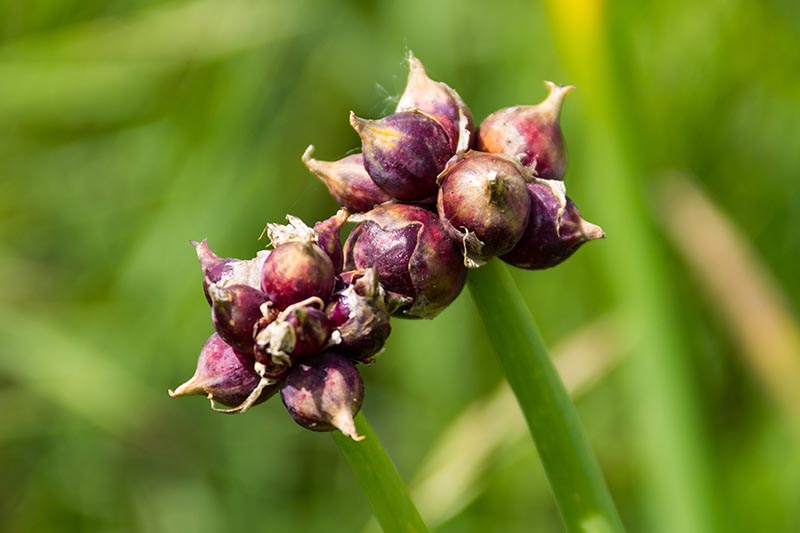
Keep in mind that the more topsets you’re harvesting, the fewer new Egyptian walking onion plants you’ll have in your garden next year. Be sure to let a few fall to the ground to reseed naturally, or plant them intentionally as described above.
Underground bulbs can be harvested and eaten as well, of course. These will be about the size of a shallot when they’re ready to dig up and harvest in late summer or fall.
When you’re in there dividing, reserve a few of the large ones for eating as well. But don’t pick too many if you want a healthy harvest the next year.
Cut stalks as well as bulblets and bulbs can be stored in the fridge for a few days. Be sure to wash them just before use. Introducing moisture prior to storage can result in rot more quickly.
Mature bulbs can also be cured in a warm location with good ventilation just like what you’d do with traditional bulb types, for longer storage.
Bulblets and chopped bulbs can be frozen after chopping and peeling, or dehydrated. Or try pickling the bulblets for a tasty treat that’s great in cocktails or as a snack, similar to what you might do with pearl onions.
What Are Egyptian Walking Onions?
The Egyptian walking onion is a hybrid of a bulb type and the Welsh bunching onion, and they’re often called walking, tree, or top-setting onions due to how they spread and propagate.
Formerly classified as Allium cepa var. viviparum, bulbiferum, or proliferum, these are now described as a hybrid, A. x proliferum.
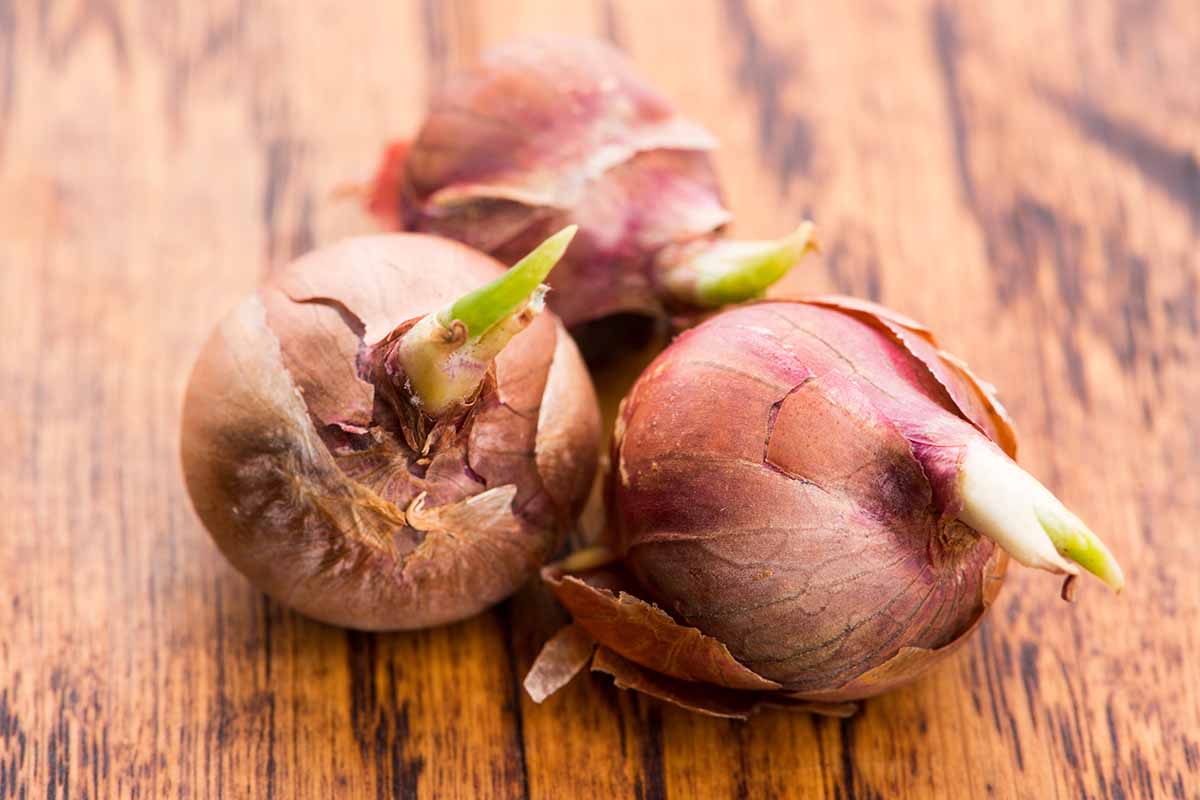
While this allium produces the fat, tasty bulb we associate with all onions, it also creates miniature “onions” at the end of long, green stalks that are called “topsets” or “bulblets.”
These topsets are edible and quite tasty, with a noteworthy kick in their flavor that tends toward something a few degrees south of the border.
While Egyptian walking onions can spread further and further underground to form a massive clump in your garden, their main method of propagation is to spread via these topsets.

When the topsets grow too heavy, the hollow green stalks will collapse to the ground. Once they’re touching the soil, these will take root and establish themselves as new individual plants.
Now you know why they’re called “walking onions,” and you get to show off that knowledge the next time they’re mentioned on Jeopardy!
Unfortunately, these plants have no special attachment to Egypt outside of their habit of walking like the inhabitants of that land….
I’m going to spare our readers any attempt at making a joke about onion mummies (mummions? oniommies?) and move us forward to their cultivation.
You have several options when it comes to propagating these plants, and this is literally the easiest type of onion that I’ve ever tried to grow in the garden. Let’s take a look.
Once you’ve planted your Egyptian walking onions in the garden and they’ve established themselves, they will freely provide you with as many baby bulblets as you could possibly want.
When the topsets grow heavy enough in the late summer and fall, the stalks will bend over from the weight and drop to the soil below.
You can also remove those topsets and plant them wherever you like if you don’t want them spreading around your garden of their own accord, or take a few from a friend that already has some growing in the garden.
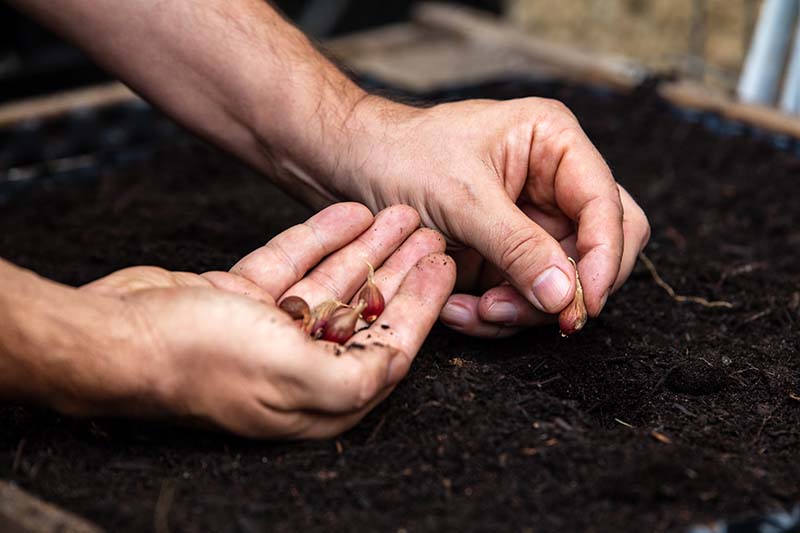
Space them about six inches apart, planted about two inches deep.
If you like a tidy and orderly garden bed, you can opt to give them lots of space, or if you want them to grow less formally you can pretty much ignore them and let them spread naturally at will with equal success.
Water them in at planting time if you’re going the extra mile and giving them a little extra help.
These topsets will grow if you let them, wherever they land, producing new plants for you to enjoy in your garden. If you do not want volunteers sprouting around the garden, make sure to cut them away instead before they fall and eat ‘em up.
Egyptian walking onions are like many perennial plants that benefit from dividing every few years in the fall.
It’s the same process that you’d use with most other perennial plants – dig them up and lift them out of the ground, and chop them into a few pieces.
It’s better to divide into a few generously-sized divisions rather than splitting off as many little ones as you can get, to start new clumps.
Plant the divisions wherever you want to have more of them.
Transplant at the same depth they were growing before, cover with some dirt (these are onions, they only need dirt, not soil), and water them in, watering again as needed for a week or two until established.
In all types of planting, you want to make sure the bulblets are just barely covered with soil. Er, dirt.
Keep them watered but allow them to dry out between waterings – don’t feel obligated to fertilize these plants – they can make do just fine with the nutrients existing in the soil they’re planted in.
If you’re the helicopter plant parent, you can amend the soil with some good compost, but make sure you let your baby onions grow and walk away from the nest at their own pace.
Before you know it, they’ll go off to onion college and have onion babies and you’ll be listening to my own cover of “Cat’s in the Cradle,” except it’s called “Topsets in the Soil” and instead of Harry Chapin breaking your heart, it’ll be me making you wish you had a set of ear plugs handy.
As forgiving as any allium, A. x proliferum only require soil that is well-drained and not completely starved of nutrients.
These mobile alliums don’t require extra watering or care in general, and can get by with a bare minimum of effort on the part of the gardener.
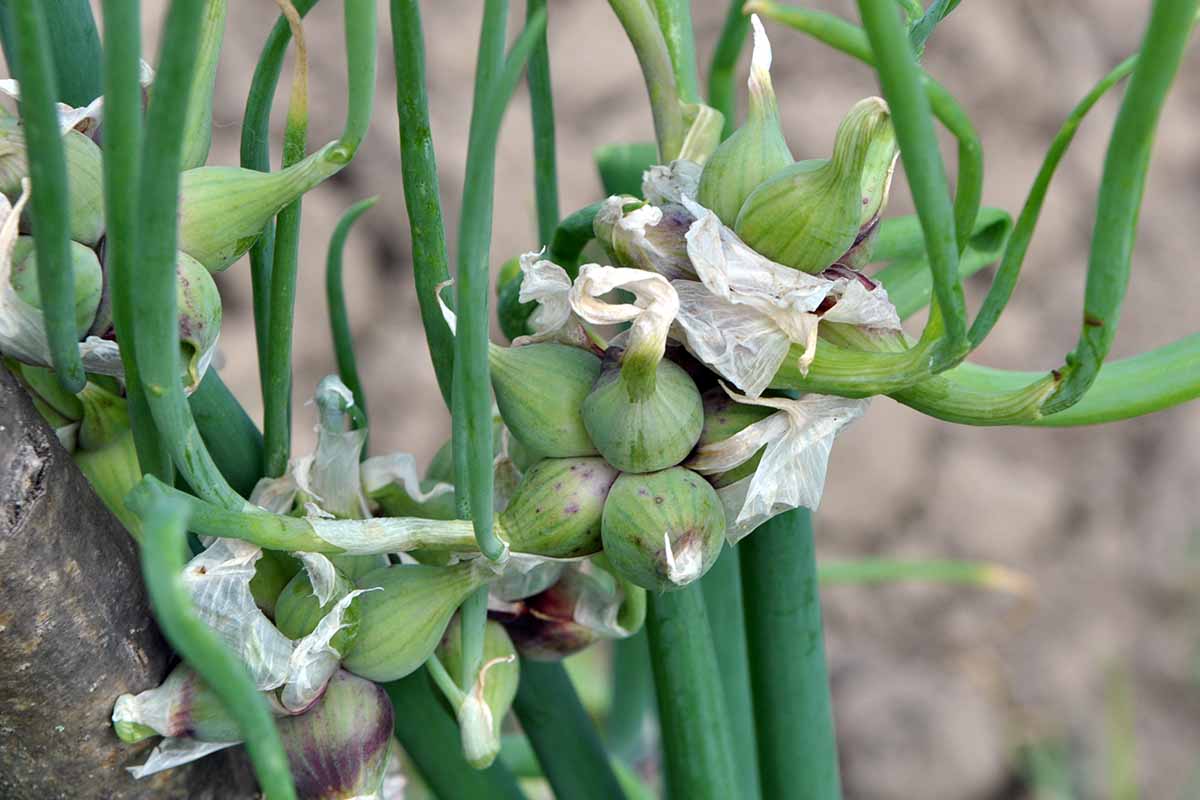
Ensure they’re getting about an inch of rain every week, and keep them in as sunny a location as you can. They can grow happily in some light shade but are at their best with as much sun as they can drink up.
I’m a firm believer that most plants are happiest when they’ve got a few weeds growing around them, as long as those weeds aren’t absolutely crowding out your intentionally planted specimens.
Plants can share their nutrients in a mycological network and, in a word – communicate – with one another about pests and dangers they are experiencing.
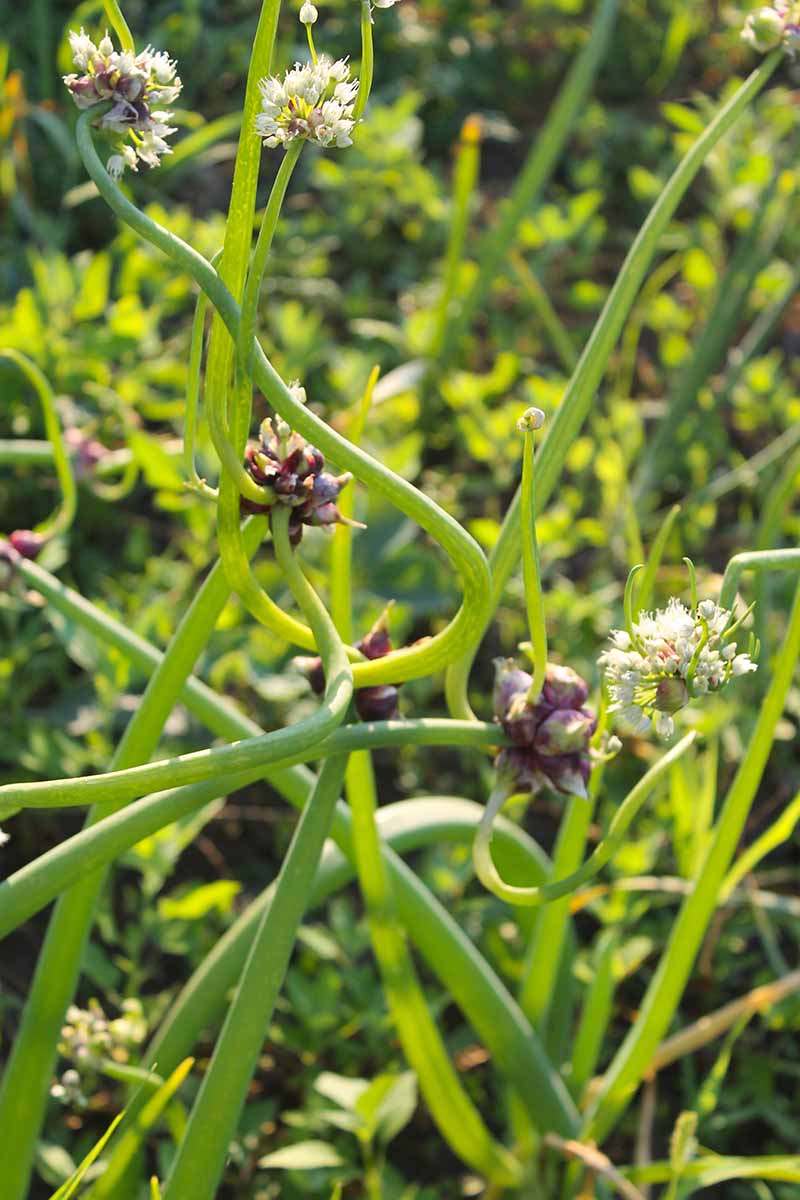
Give your walking onions a few friends by allowing a handful of scattered weeds to share the planting area with them.
I can’t promise your onions will be more vigorous or delicious, but I can definitely guarantee everybody involved will be happier for your (lack of) effort in removing that handful of annoying weeds.
If you do not want your onions to grow outside of the area you’ve given them, you’ve got to harvest them every time a topset begins to form.
These guys are so very eager to take off and spread wherever they can, so you’ve got to be like Cruella de Vil and harvest as many baby bulblets as you can before they reach mature size.
To encourage bigger bulb growth underground you can also snip the developing topsets. But then you’d remove the “walking” aspect of these plants – and where’s the fun in that?!
- Give your plants space to grow, and divide to ensure a bountiful future harvest.
- Fertilization and heavy-handed care is not necessary!
- Remove bulblets before they drop if you don’t want them to spread beyond your designated spaces.
This might be my favorite part about my favorite allium:
There are no cultivars to select that are available commercially beyond the species plant.
It’s simplicity in the best way, a distinct and flavorful onion that walks the walk and goes by a single name.
In the future, there may be some fancy cross-breeding attempts, but right now, this is a plant you’re only going to find listed as “Egyptian walking onion,” or one of its synonyms.
Plants are available in packs of five from Burpee.
